Repairing a torn anterior cruciate ligament: is it a good idea?
Can the reconstruction of the anterior cruciate ligament, considered the gold standard, be replaced by the repair of the anterior cruciate ligament? A viable alternative or an Innovation with limitations.
Introduction
The development in knee surgery, particularly in the treatment of the anterior cruciate ligament (ACL), is constantly evolving. Over the years, the treatment of the ACL has undergone changes, improvements, and further adaptations. One of the recent advancements is the rediscovery of a ligament called the Anterior Lateral Ligament (ALL) (the ALL) is mentioned. But as mentioned earlier, developments are constantly progressing. Dr. R.A.G. Hoogeslag, recently, at Orthopedisch Centrum Oost Nederland (OCON) in Hengelo, a researcher successfully defended his doctoral thesis on the repair of the torn anterior cruciate ligament (ACL). In this blog, you can learn more about the technique of ACL repair and its outcomes. Will we see this new approach in practice, or are there still obstacles to overcome?
What is an anterior cruciate ligament?
To begin, it is important to understand the question: what is an anterior cruciate ligament (ACL)? The ACL is a band located in the center of the knee that connects the thigh bone to the shinbone. The ligament consists of blood vessels, nerves, and cells. These components, along with tough collagen fibers, form a strong ligament. The ACL is a crucial structure in the knee that provides stability and control during movements such as running, jumping, and pivoting. A torn ACL often leads to instability symptoms and limitations in sports activities.
ACL reconstruction is considered the gold standard for treating a torn ACL.
The treatment for a torn cruciate ligament is an anterior cruciate ligament (ACL) reconstruction. The stability of the knee is restored by het nabootsen van de kruisband met een pees (From which tendon is your anterior cruciate ligament (ACL) made?). This is the gold standard for treating anterior cruciate ligament (ACL) injuries. Previous alternatives, such as replacing the ligament with synthetic materials, have proven to be of insufficient quality. The question addressed in the doctoral thesis is Dr. R.A.G. Hoogeslag The central focus of the thesis is whether the original anterior cruciate ligament (ACL) can be repaired instead of replaced. The ACL is well vascularized, and the blood contains the necessary components for healing, which offers promising prospects.
Why suturing a torn cruciate ligament is an intriguing treatment option?
The anterior cruciate ligament (ACL) is a complex structure with specific anatomy and functions. Together with other ligaments, the ACL plays a crucial role in maintaining the biomechanics of the knee. The mechanosensors present in the ACL, in collaboration with other structures such as ligaments and the joint capsule, provide neuromotor control of muscles during movement. A tendon used for ACL reconstruction can never fully replicate these specific characteristics of the native ACL. Therefore, suturing a torn ACL presents an intriguing treatment option. Additionally, patients may experience discomfort at the site where a tendon graft is harvested for ACL reconstruction. This is not the case when the torn ACL is repaired through suturing. It is also known that the risk of developing knee osteoarthritis increases after an ACL injury, regardless of whether it is treated surgically or not. It would be beneficial if suturing the ACL could restore knee biomechanics and potentially reduce the risk of knee osteoarthritis.
There are three methods of anterior cruciate ligament (ACL) suturing:
The anterior cruciate ligament (ACL) is well-vascularized, and research indicates its potential for healing. However, a challenge in the knee joint is the immediate washout of blood and its associated healing components. This prevents the torn ACL from properly reattaching itself. By suturing the anterior cruciate ligament, both ends are brought together, allowing the ligament the opportunity to fuse and heal properly. This technique aims to create an environment that facilitates the healing process and promotes successful integration of the ACL.
Three methods of suturing are described, one with and two without internal bracing.
- No augmentation: only suturing of both ends.
- Static augmentation: A thin but highly durable wire is tensioned like a brace along the cruciate ligament and attached to the thigh and shin bones.
- Dynamic augmentation: A similar type of wire is tensioned like a brace along the cruciate ligament and attached to the thigh bone. The end of the wire in the shin bone is connected to a spring system to regulate the tension.
Research indicates that suturing alone without augmentation does not sufficiently restore knee stability. Static and dynamic augmentation techniques yield better results, and the outlook is favorable. A study with a two- and five-year follow-up demonstrates that dynamic augmentation is equivalent to anterior cruciate ligament (ACL) reconstruction. However, caution should be exercised when applying this surgical technique to young, active athletes.
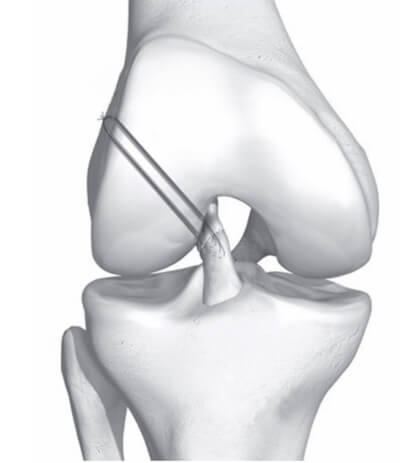
No augmentation.
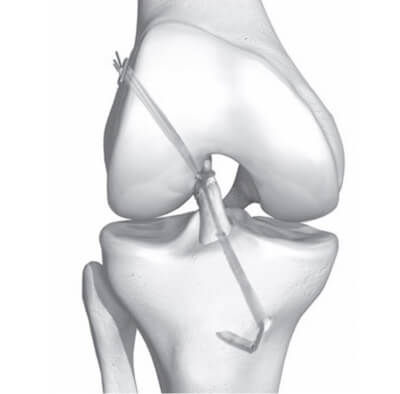
Static augmentation.
What does the procedure of anterior cruciate ligament (ACL) suturing look like?
If the patient meets the surgical criteria, the operation should be performed within three to four weeks. Before the surgery begins, the knee is examined again. Afterward, the procedure commences. The torn anterior cruciate ligament (ACL) is prepared with sutures. The dynamic augmentation, known as the Ligamys monobloc fixation device, is then inserted into the tibia.
What is a Ligamys?
The Ligamys monobloc is a cylinder with a threaded length of 30 millimeters and a diameter of 10 millimeters. It contains a spring system to maintain consistent tension on the Ligamys wire during movement. The Ligamys is slightly larger in size compared to a fixation screw commonly used for securing the graft in anterior cruciate ligament (ACL) reconstruction. The button, which is often used in ACL reconstruction, is much smaller in comparison to the Ligamys (2x1x8mm). Recently, the company Mathys released a smaller variant of the Ligamys monobloc with an 8mm diameter to address concerns about its size.
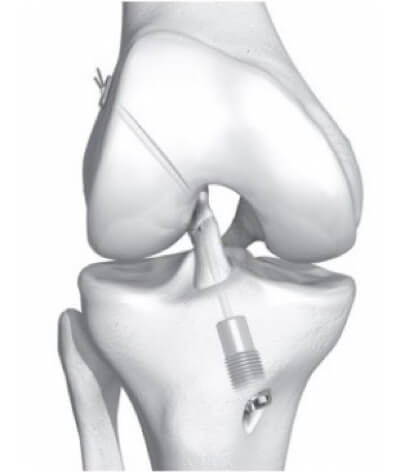
Dynamic augmentation
Continuation: What does the procedure of anterior cruciate ligament (ACL) suturing look like?
Additionally, a narrow tunnel is drilled in the femur (thigh bone), and the sutures in the anterior cruciate ligament (ACL) are threaded through this tunnel to the outside. A slender yet sturdy Ligamys wire is then secured to the femur bone using a button. It is guided through the tunnel in the femur, along the torn ligament, and through the tunnel in the tibia (shinbone) to the Ligamys monobloc. The sutures in the anterior cruciate ligament are tensioned, bringing both ends of the ligament together. The Ligamys wire is also tensioned and anchored to a robust spring in the Ligamys monobloc. This strong spring accommodates any length difference in the knee during bending and stretching, ensuring that the Ligamys wire remains taut at every angle of knee flexion to protect the sutured anterior cruciate ligament during the healing process. The incisions are closed, and the surgery is concluded. The entire procedure typically lasts approximately 45 to 60 minutes.
Can every torn anterior cruciate ligament (ACL) be sutured?
A torn anterior cruciate ligament (ACL) should be sutured within 3-4 weeks. Therefore, a patient should promptly seek medical attention after a knee injury to be diagnosed. An MRI scan should be performed to determine the diagnosis, severity, and type of ACL tear. If the ligament tears near its attachment to the femur bone, it is the most favorable location for suturing. However, it can be challenging to accurately assess the type of tear with an MRI scan. During arthroscopic surgery, it will be determined whether the ACL can be successfully sutured. If it is not possible to suture the ligament, a reconstruction of the anterior cruciate ligament using a patient's own graft will be performed instead.
The results of anterior cruciate ligament (ACL) repair supported by dynamic augmentation.
Research conducted by Dr. R.A.G. Hoogeslag indicates that the outcomes of dynamic augmentation are comparable to those of anterior cruciate ligament (ACL) reconstruction. The differences in terms of pain, resumption of daily activities, and return to sports are small. The number of re-ruptures between the two groups is also similar. From a scientific perspective, no statistically significant differences were found in terms of complications and reoperations. However, it is important to interpret these results with caution as the study involved a small sample size within the specific age group of 18-30 years. In absolute terms, the number of reoperations was slightly higher in the group with dynamic augmentation. The main reasons for reoperation were the removal of excessive scar tissue (cyclops lesion) and the monobloc fixation of Ligamys. While the prospects are promising, further research, experience, and development are needed to fully embrace dynamic augmentation as a complement to ACL surgery.
Healing a torn anterior cruciate ligament (ACL): a good idea? Let us know your thoughts in the comments.
Link:
Podcast with Dr. Roy Hoogeslag on suturing the anterior cruciate ligament. click here.
Advantages and disadvantages of anterior cruciate ligament suturing. click here
To learn more about the future of anterior cruciate ligament (ACL) suturing, please click here.
Want to know more the study on anterior cruciate ligament suturing click here.
This blog is in collaboration with Dr. Roy Hoogeslag . Thank you very much for your contribution.


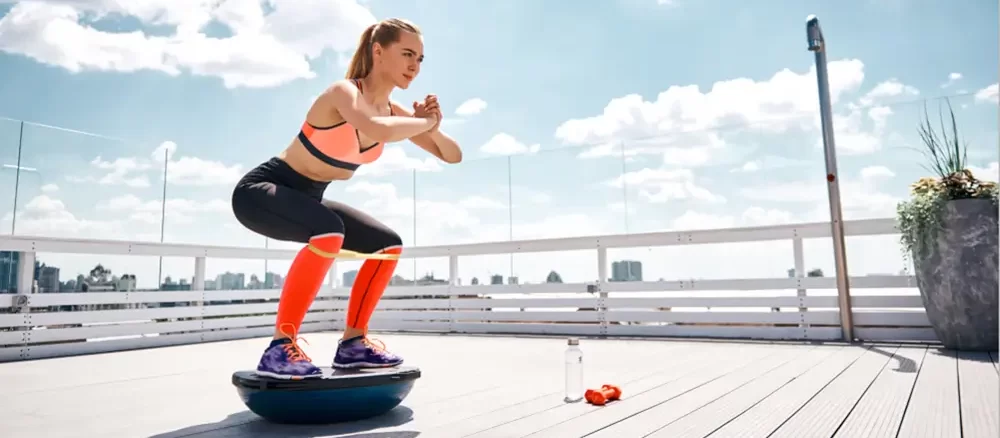
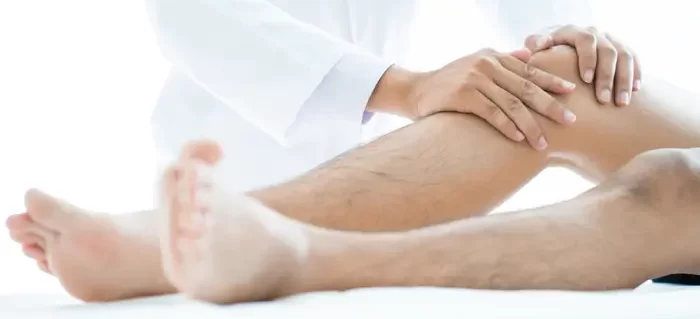

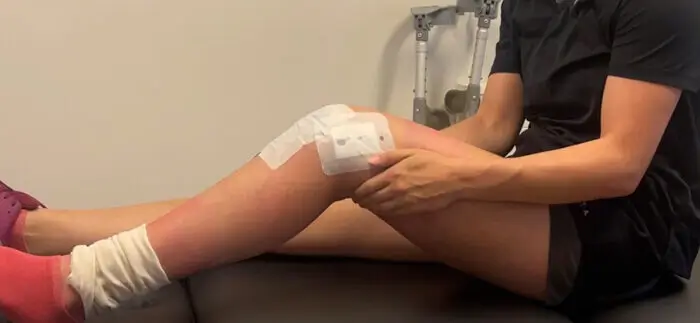

Technisch bekeken lijkt een hechting veel betere vooruitzichten te hebben dan een reconstructie later met bv een autograft doordat de origo en insertie precies op de juiste plaats (blijven) zitten (dat lukt bij een reconstructie vaak toch niet helemaal).
Ook de lengte hersteld weeer op de juiste lengte.
In de onderzoeken wordt veel te veel gekeken of de operatie “kan” en veel te weinig naar lange termijn klachten in brede zin.
Operatie technieken als Lygamis en “internal bracing” zouden de gouden standaard moeten worden.
Zeker als je naar alle hamstring problemen na reconstructies kijkt (vaak wordt alleen de knie bekeken) en worden secundaire hamstring klachten buiten beeld gelaten, maar kijk maar eens naar de blessure lijst van bv Mempis Depay na zijn reconstructie !
Mooie toevoeging.
Momenteel worden er nog steeds studies uitgevoerd naar het hechten van de voorste kruisband, en tijdens internationale congressen wordt hier ook uitgebreid aandacht aan besteed.
Naar mijn mening verdient het herstellen met lichaamseigen materiaal altijd de voorkeur. Natuurlijk zijn er ook enkele nadelen, zoals het feit dat de operatie binnen 3 weken moet worden uitgevoerd, niet elke scheur van de voorste kruisband kan worden gehecht, en niet iedereen hoeft te worden geopereerd. Echter, door de tijdsdruk van 3 weken bestaat de kans dat meer mensen onnodig worden geopereerd.